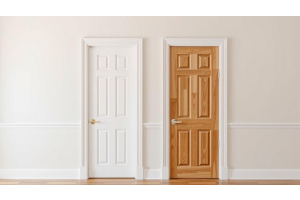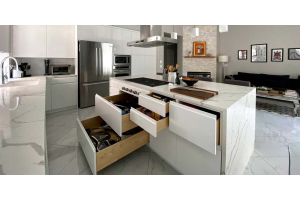
When learning how to cut fluted panels, precision is key to achieving a professional finish. Fluted wood panels can add a stylish, textured look to any room, but proper cutting and installation are essential to making them stand out.
One of the most important fluted wall panel installation tips is to always measure carefully and use the right tools, like a circular or table saw, to ensure clean cuts. Whether you're fitting panels around windows or outlets, following a methodical approach to cutting and installing fluted wood panels will help create a seamless, visually appealing accent in any space.
Installing panels on walls with obstructions, like windows or outlets, means you'll have to make a few cuts. Don't panic! We have all the DIY tips, from how to measure fluted wall panels to how to fix fluted wall panels.
Tools and Materials to Cut Fluted Panels
There are essential tools you will need to cut your fluted panels. Depending on the cut you're trying to make, you may need a range of different tools. You can ask a neighbor to borrow a tool or take a trip to the hardware store before starting the project.
Here is a list of essential tools:
- Saw: There are a variety of saws you can use to cut fluted panels. A circular saw with a sharp blade is a great option. However, you can use a simple hand saw if you don't have a circular saw.
- Straight edge guide: A straight edge guide will help you make accurate cuts.
- Clamps: Clamps are crucial for holding the fluted panel in place when cutting. You don't want it to move around when trying to cut straight.
- Ruler/measuring tape: You'll want a ruler and measuring tape to mark exactly where to cut.
- Safety equipment: Use safety goggles to shield your eyes from debris. You should wear gloves to protect your hands when working with the saw.
Choosing the Right Tool
Choosing the right tool will set you up for success. One wrong cut could be a pivotal failure in this DIY project. Here's a guide to tools and their specific uses:
- Circular saw: Circular saws can make compound cuts and are more versatile because they can cut through metal and even concrete. If you're making a curved cut, use a circular saw.
- Table saw: Table saws are ideal for making straight cuts in wood and plywood. They’re ideal for cutting fluted panels when making straight or angled cuts.
- Hand saw: A hand saw is a great tool for smaller projects. It gives you more control and allows for precise cuts. Select a hand saw with fine teeth to make the most accurate cuts.
Cutting the Fluted Panel
With the right tools prepared, it's time to cut your fluted panels.
- Clamp your panel: Start by securing the panel with your clamps to ensure it doesn't move.
- Measure and mark: Take the necessary measurements and use a pencil to mark the panel exactly where you need to cut. Double-check your calculations before you cut.
- Test cut: Start with a test cut to ensure the saw is going through the panel smoothly and accurately.
- Make the cut: Move the saw slowly and steadily as you go to ensure a clean cut. You don't want to force it through the material because it can splinter.
- Sand the edges: Once you've finished cutting, use sandpaper to smooth out your work.
- Spot imperfections: Look over the cut, make sure there are no imperfections, and make any adjustments before mounting it to the wall.
Troubleshooting Common Issues
Problems often arise during DIY projects, even with careful planning. There is generally a way to make corrections if you run into issues.
- Splintering or tear-out: Wall panels made out of MDF can sometimes splinter or tear. If you experience this problem, apply painter's tape to your cutting line before making any more cuts. It will help mitigate the problem.
- Unevenness: If your cut is uneven, it may be because you aren't using consistent pressure or movement. Try applying consistent pressure and guide the saw using even movements.
- Sharpen the blade: Your blade may be the problem if you aren't getting the desired cuts. Make sure you sharpen your blade to get the cleanest cuts.
A Panel-Cutting Pro
Following this guide will help you cut fluted wall paneling like a professional. Always gather the necessary tools and measure everything before getting started. Remember to go slowly and apply consistent pressure to get the best edges when cutting. Your new accent wall will be a beautiful addition to your space!






